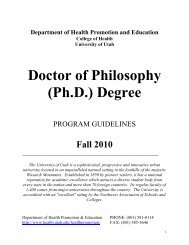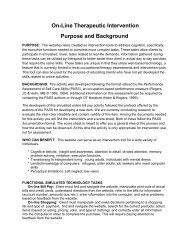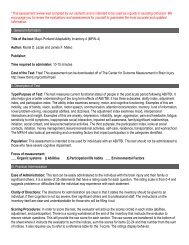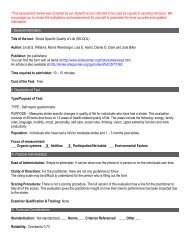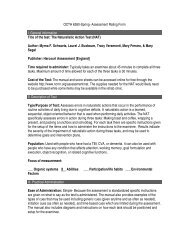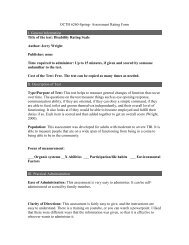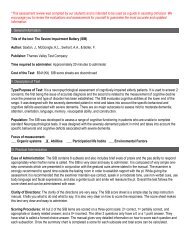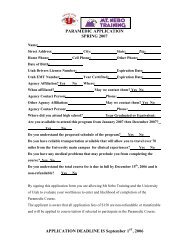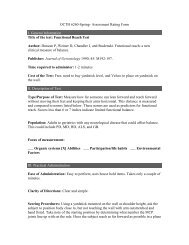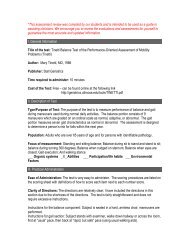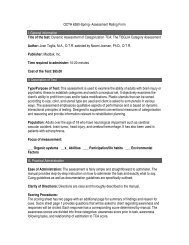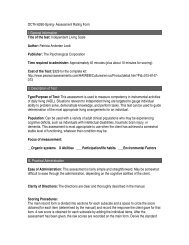Revisiting speech rate and utterance length ... - ResearchGate
Revisiting speech rate and utterance length ... - ResearchGate
Revisiting speech rate and utterance length ... - ResearchGate
You also want an ePaper? Increase the reach of your titles
YUMPU automatically turns print PDFs into web optimized ePapers that Google loves.
M. Blomgren, A.M. Goberman / Journal of Communication Disorders 41 (2008) 159–178 175CE Questions:1. As discussed in this paper, two of the most widely examined factors thought to influencestuttering frequency are:a. <strong>speech</strong> <strong>rate</strong> <strong>and</strong> <strong>utterance</strong> <strong>length</strong>.b. <strong>speech</strong> <strong>rate</strong> <strong>and</strong> the specific word initial phoneme.c. <strong>utterance</strong> <strong>length</strong> <strong>and</strong> age of listener.d. age of stuttering onset <strong>and</strong> duration of stuttering moments.2. A ‘‘closed’’ motor skill:a. occurs in a non-stable environment.b. includes aspects of a task that change during performance of the task.c. occurs in a temporally <strong>and</strong> spatially stable environment.d. tends to be spatially <strong>and</strong> temporally complex.3. The ‘‘variable <strong>rate</strong>’’ tasks utilized in this study included:a. reading a series words at a slow <strong>rate</strong> of <strong>speech</strong> <strong>and</strong> a series of phrases at a fast <strong>rate</strong> of<strong>speech</strong>.b. reading numerous paragraph <strong>length</strong> texts at variable speaking <strong>rate</strong>s.c. reading a series of single words <strong>and</strong> a series of phrases at alternating slow, normal<strong>and</strong> fast <strong>rate</strong>s of <strong>speech</strong>.d. reading a series of words three times each at a normal speaking <strong>rate</strong>.4. The overall findings of the specific 2 2 <strong>speech</strong> performance matrix utilized in thispaper indicated that:a. stuttering frequency was most influenced by the linguistic complexity variable.b. stuttering frequency is most influenced by temporal complexity variable.c. stuttering was most influenced by the words <strong>and</strong> phrases beginning with consonants.d. stuttering was influenced by both <strong>length</strong> of <strong>utterance</strong> <strong>and</strong> <strong>speech</strong> <strong>rate</strong> variability(temporal complexity).5. In the present study, the relatively less severe (milder) stuttering speakers tended tostutter most:a. during the stable <strong>rate</strong> tasks.b. during the longer <strong>utterance</strong>s.c. during the variable <strong>rate</strong> tasks.d. during the shorter <strong>utterance</strong>s.ReferencesAndrews, G., & Harris, M. (1964). The syndrome of stuttering. London: Heinemann.Au-Yeung, J., & Howell, P. (1988). Lexical <strong>and</strong> syntactic context <strong>and</strong> stuttering. Clinical Linguistics <strong>and</strong>Phonetics, 12, 67–78.Blomgren, M. (2001). Reinventing the wheel: New approaches to programming complexity in stuttering therapy.In H. Bosshardt, J. Yaruss, & H. Peters (Eds.), Fluency disorders: Theory, research, treatment <strong>and</strong> self-help(proceedings of the third world congress of fluency disorders) (pp. 114–118). Nijmegen: Nijmegen UniversityPress.Blomgren, M. (2005). Intensive stuttering therapy: A programmed approach for adults <strong>and</strong> adolescents. AnnArbor, MI: Copley Custom Textbooks – National Archive Publishing Company.



